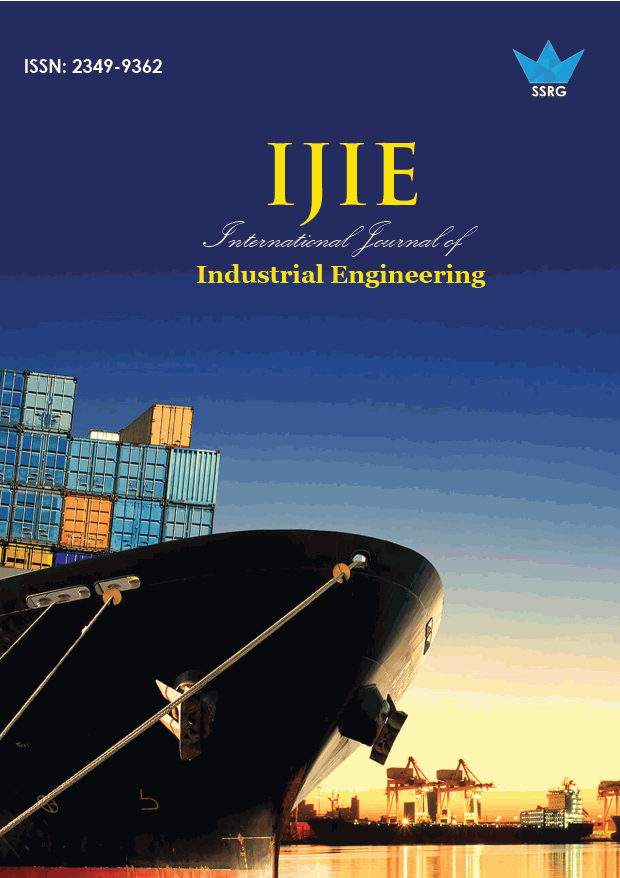Improving Quality and Work Quality at the 2019 World Skills Competition in Industrial Control

| International Journal of Industrial Engineering |
| © 2018 by SSRG - IJIE Journal |
| Volume 5 Issue 3 |
| Year of Publication : 2018 |
| Authors : Mahefud Ismail, Mohamad Nurdin and Humiras Hardi Purba |
How to Cite?
Mahefud Ismail, Mohamad Nurdin and Humiras Hardi Purba, "Improving Quality and Work Quality at the 2019 World Skills Competition in Industrial Control," SSRG International Journal of Industrial Engineering, vol. 5, no. 3, pp. 1-6, 2018. Crossref, https://doi.org/10.14445/23499362/IJIE-V5I3P101
Abstract:
This research discusses how to increase value and quality in the field of Industrial Control internationally, the World Skills Competition held once every 2 years and in every odd year, the Indonesian membership has started from 2003 and continues to this day. World ranking competitions such as the World Skills Competition are here to find out the extent to which the competence of the nation is internationally recognized, as well as to represent in the name of the Nation and Indonesia namely Indonesia, Indonesia follows 29 fields of racing from 51 existing racing fields and our company participated in the automation field of "Industrial Control ". That was carried out on 14th to 18th October 2017 at ADNEC, Abu Dabi. Subsequently in September 2019 the plan will be held in Russia. The method used will be a pareto chart with the help of 5M and Fishbone analysis. It is hoped that with this method the results will be increased at the World Skills Competition 2019 in Russia will increase and the target is to win gold for Indonesia. From the aspect of improving the quality of work, things that need to be done are to make continuous improvements to the ability and expertise of participants in the field of industrial control.
Keywords:
capacitated production planning problem; stochastic demand; simulation; cyclic coordinate method.
References:
[1] Pylväs, L., & Nokelainen, P. (2017). Finnish WorldSkills Achievers’ Vocational Talent Development and School-to-Work Pathways.
[2] Roos, G. (Ed.). (2014). Global perspectives on achieving success in high and low cost operating environments. IGI Global.
[3] Yong, B. S., Hyun, R. D., & Jung, S. S. (2015). The Development of WorldSkills Competition Mobile Robotics Course for improving the STEM convergence capability of technical high school student. International Information Institute (Tokyo). Information, 18(6 (A)), 2253.
[4] Saarinen, H., & Eerola, T. (2007). WorldSkills 2005 Helsinki: World Championship Competition in Vocational Skills Top excellence, success and learning together.
[5] HU-Jie, W. A. N. G., & Xu-ren, C. H. E. N. (2009). The Impression and Enlightenment of 40~(th) World Skills. Journal of Qingdao Technical College, 4, 013.
[6] Pylväs, L., & Nokelainen, P. (2017). WorldSkills achievers’ and their co-workers’ and employers’ perceptions of vocational expertise and school-to-work pathways. International Journal for Research in Vocational Education and Training, 4(2), 95-116.
[7] Gorlach, I. A. (2017). GMSA Chair as an Example of University-Industry Collaboration. Journal of Advanced Management Science Vol, 5(2).
[8] Jingjun, C. (2017). The Necessity of the Development of the TrainingWall inWorldskills Information Network Cabling. Computer & Telecommunication, 1(12), 79-80.
[9] Barros, T. T., & Lages, W. F. (2012). Development of a firefighting robot for educational competitions. In Proceedings of the 3rd Intenational Conference on Robotics in Education.
[10] James, S. (2014). What contributes to vocational excellence?: a pilot study of the individual characteristics of the WorldSkills UK 2011 Squad.
[11] James, S., & Holmes, C. (2012). Developing vocational excellence: learning environments within work environments. SKOPE Research Paper No, 112.
[12] Cullison, A., Campbell, K., Guzman, C., & Johnsen, M. R. (2013). FABTECH 2012. Welding journal, 92(1), 28-36.
[13] XU, Y. F., & AN, L. (2012). Based on the Chemical Competition of Higher Vocational Teaching Reform Research [J]. Journal of Shandong Institute of Commerce and Technology, 5, 014.
[14] Currie, J., Beckerleg, M., & Collins, J. (2009). Software evolution of a hexapod robot walking gait. International journal of intelligent systems technologies and applications, 8(1-4), 382-394.
[15] Chunxiao, W., Chunyi, L., & Yan, Z. (2013). Direction of Skills Competition on Development of Chemical Engineering Courses. Guangdong Chemical Industry, 15, 132.
[16] Milln, N. H., Milln, C. J., & Curtains, A. S. NEWS SPECIFIER MAY 2013.
[17] Challenges, N., & CHANCES, N. (2011). Further Education and Skills System Reform Plan: Building a World Class Skills System.
[18] Pylväs, L., Nokelainen, P., & Roisko, H. (2015). The role of natural abilities, intrinsic characteristics, and extrinsic conditions in air traffic controllers’ vocational development. Journal of Workplace Learning, 27(3), 241-263.
[19] Nokelainen, P., & Ruohotie, P. (2009). Characteristics that Typify Successful World Skills Competition Participants. San Diego.
[20] Malter, A. J., & Dickson, P. R. (2001). The effect of individual learning on competitive decision-making and firm performance. International Journal of Research in Marketing, 18(1-2), 99-117.
[21] Clements, A. (2003, November). Constructing a computing competition to teach teamwork. In Frontiers in Education, 2003. FIE 2003 33rd Annual (Vol. 2, pp. F1F-1). IEE
[22] Caldeira, T., Al Remeithi, H., & Al Raeesi, I. (2017, April). MyRIO based mobile robot for rescue competitions. In Autonomous Robot Systems and Competitions (ICARSC), 2017 IEEE International Conference on (pp. 172-177). IEEE
[23] Weinert, H., & Pensky, D. (2011, September). Mobile robotics in education and student engineering competitions. In AFRICON, 2011 (pp. 1-5). IEEE.
[24] Weinert, H., & Pensky, D. (2012, November). Mobile robotics in education—South African and international competitions. In Robotics and Mechatronics Conference of South Africa (ROBOMECH), 2012 5th (pp. 1-6). IEEE

 10.14445/23499362/IJIE-V5I3P101
10.14445/23499362/IJIE-V5I3P101